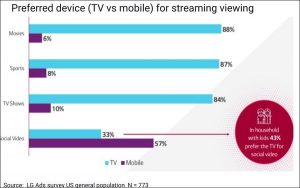Social media is a pretty powerful tool from a monetary perspective. The right strategy can generate more leads and, ultimately, more money. Your company might already be active on a handful of social networks, but you can’t expect any financial success if you don’t have a following.
Full disclosure: a dedicated social following won’t magically appear overnight. It might take a few months before your social presence really starts to gain traction, so don’t get discouraged.
Follow these tips for building an organic social media following, keep plugging away and over time you’ll see your audience—and your wallet—grow.
1. Choose your networks wisely.
You don’t have to have a presence on every social network—just the ones you know are worth your time. Otherwise, you risk spreading yourself too thin. It’s better to be absolutely crushing it on one platform than doing a lackluster job on five.
Start by gathering some intel on your audience. Who are they? Where are they spending their time on social media? What do they want? It’s as easy as asking. Send your email list a 1-3 question survey about their social habits. Having a thorough understanding your audience’s behavior will help you streamline your efforts.
Check out what your competitors are up to. A little reconnaissance goes a long way. What are your competitors up to on social? A simple Google search will yield a ton of results.
Pick about five competitors to use as a benchmark. How many followers do they have on each of their networks? What kind of content are they sharing and how often are they sharing it? Are people engaging with said content?
What’s working for your competitors will likely work for you. More importantly, what’s not working for them probably won’t work for you either.
2. Perfect your presence.
It’s important to optimize your online presence, whether you’re freshening up an existing social platform or creating an entirely new one. If your brand is active on multiple platforms, it’s important to maintain some level of consistency.
Although social networks are all visually different, your profile should ideally “feel” the same across the board. This makes your profiles easy to recognize and more professional. A few things every social profile should include:
- A recognizable username (keep it consistent from platform to platform)
- A recognizable profile photo (you can’t go wrong with a company logo)
- A brief, keyword-rich description of your company
- A trackable link that directs visitors to your website
3. Beef up your content.
You need to make sure your presence is actually worth following, and that starts with content. This ties back to how important it is for you understand your audience because the content you share has to be interesting to them.
Follow the 80/20 rule. That is, 80% of your content should be entertaining and interesting to your audience, i.e. relevant articles from reputable sources, visuals, questions, quotes, industry insights and anything else that is shareable. The other 20% can be self-promotional and call-to-action oriented: special offers or discounts, new blog post promotions and anything that links back to your website.
Keep it fresh and fun. A Facebook feed that’s loaded with links to articles is dull and uninspiring. Maintain your audience’s interest by serving up different types of content. Entertain them by sharing content that humanizes your brand, makes you laugh, or plays off of buzzy current events like the Olympics or the Super Bowl.
4. Promote like you’ve never promoted before.
If you’ve taken the time to optimize your social presence, don’t let your efforts go to waste. Promote your social presence and don’t be discreet about it.
Talk to your real-life social network. A Facebook page built from scratch with “likes” in the double digits looks unestablished and can be a turn-off for potential followers, so ask your real-life connections to engage with your profile by liking, following, sharing and commenting. Have your coworkers encourage their connections to do the same. If you create a buzz and get the conversation started, more people are likely to jump on board.
Hold a contest or giveaway. This is a great way to increase engagement. Using the “share to win” method on social media like Facebook and Twitter will get your message in front of more people, getting you more impressions and followers in return.
Utilize social media icons. Incorporate icons to your social profiles wherever applicable: in the footer of your website, on your blog, in your email messaging, on your business cards, in your advertising, in the window of your storefront, etc.
Cross promote across the platforms you already use. If you have an established Facebook following, tell your followers to follow you on your new Twitter/Instagram/Snapchat/etc. Make it easy for your audience to share your content by incorporating social sharing buttons into your blog posts, emails, etc.
Reach out to influencers. An influencer is a person who has an impact on a specific market and a social following, like a CEO, a food writer, or a tech blogger. Engage with influencers who are in the same industry as you by sharing their content with your followers.
If you have a blog, ask an influencer to write a guest post. Having a recognizable influencer appear on your website not only validates your credibility, but could lead to more followers when the influencer shares the blog with their followers. Buzzsumo is a great tool to find the movers and shakers in your industry.
5. Be consistent.
Sharing a link to an “interesting” article to your Facebook page when you remember to won’t do much in terms of building an engaged social following. Once you figure out what your audience responds to most over time, you’ll be able to consistently deliver.
You don’t want to post content so sporadically that your company’s name never has the chance to stick with your audience, but you don’t want to overwhelm (re: annoy) them either. Aim to post once or twice a day.
Use a social media management tool (we like Buffer) to schedule out your content ahead of time. Experiment with the timing of your posts to see when you’re likely to get the most engagement.
6. Be interactive.
Social media is just that: social. Use it for its intended purposes by interacting with your followers and anyone who mentions you, and make your content easy to interact with by mentioning, linking and hashtagging wherever you see fit. Use Hashtagify to find other hashtags similar to the one you’re targeting.
Check for mentions of your company and related hashtags every day and take the time to respond. If someone says something nice, thank them. If they don’t have something nice to say, try to resolve it.
Digital & Social Articles on Business 2 Community
(24)






